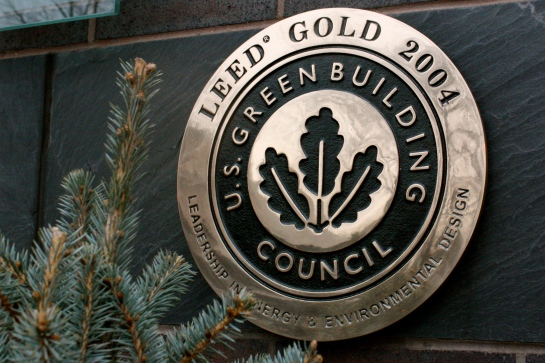Battery Park City is in one of Manhattan’s most vulnerable flood zones. How did Hurricane Sandy turn a neighborhood expected to wash away into a model for safe waterfront living?

The Solaire, at 20 River Terrace in Battery Park City, was the first LEED Gold Certified residential building in the United States.
On the evening of Monday, October 29, 2012, CNN’s Erin Burnett stood knee-deep in the nearly 14-foot tidal surge that breached the Promenade at Battery Park City and described the record-breaking flood waters encroaching on the neighborhood to viewers.
“You’ve got the Hudson River right here, behind me,” Burnett said with a sweep of her left arm, “and then now the highway on the other side behind where all these buildings are is also completely flooded. It’s up to eight or nine feet.”
Burnett was just one of a raft of rain-slickered reporters who logged hours of footage from the River Walk that runs along the neighborhood’s western boundary leading up to and during Hurricane Sandy’s assault on Lower Manhattan.
Media predictions for wind and flood-related damage to Battery Park City were uniformly grim. But just two days after the historic storm that battered parts of New York City into total submission, the neighborhood perched precariously on the southwestern edge of the island was up and running, due in large part to sustainable “green” buildings—the first among their kind—that met the inaugural challenge of this magnitude head on.
“Battery Park City is one of the least impacted areas, in an iconic way,” said Battery Park City Authority spokesman Matthew Monahan. In the weeks since the hurricane, he’s become fond of referring people to a New York magazine aerial cover shot of the island shrouded in darkness, with the exception of the glittering nugget in the lower left quadrant.
“Because the lights stayed on,” Monahan said, “it was an inconvenience for certain, but the degree of impact would be less than other parts of the city.”
—
Modern planned communities and Walt Whitman may seem unlikely associates, but the excerpt from Whitman’s “City of Ships,” scattered letter by metal-block-letter across a railing near North Cove Marina in Battery Park City provides an apt description of the Lower Manhattan neighborhood.
“City of wharves and stores–city of tall facades of marble and iron!”
Standing at the railing, as strollers roll among suit-wearing financiers headed to nearby offices on Saturday morning and the lawns are designated “dog-free,” examples of all three pieces of infrastructure, as described by the poet, are within view.
Battery Park City has been, from its inception, a place ordained by deliberate decisions. Nestled between West Street and the Hudson River, the neighborhood was built in the 1980s and atop land reclaimed during the construction of the World Trade Center the previous decade, and named for nearby Battery Park.
The Battery Park City Authority (BPCA) owns the land on which the luxury residential high-rises, hotels, and commercial properties by which it is characterized rest. The BPCA leases the land to private developers, and requires adherence to strict construction guidelines.
Despite the community’s waterfront location, disaster preparedness has not been something that leasing agents have, to this point, emphasized about residential properties. Rather, green buildings erected over the past decade in the so-called “North Residential Neighborhood” of Battery Park City such as Liberty Green, the Verdesian, the Visionaire, and the Solaire attracted residents not only with sweeping views of the Hudson River and proximity to offices in the Financial District, but by promising a convenient urban lifestyle with a reduced impact on the environment.
The Solaire, at 20 River Terrace, was the first residential building in the U.S. to achieve LEED Gold certification when it opened in 2003. The tower earned at least 80 out of 100 points on the scale designed by the U.S. Green Building Council to measure factors including a building’s energy and water efficiency and use of materials. The twenty-seven story edifice cost approximately $114 million to construct.
Six years later the Visionaire opened at 7 Little West Street. Boasting a thermal well-powered climate system, on-site water treatment and reclamation process, and one-hundred percent recycled glass and terra cotta façade, it was granted LEED Platinum status.
According to a representative of the Albanese Organization, which built the Solaire, Verdesian, and Visionare, units have been in high demand since the buildings opened. The Visionaire, where two bedroom condominiums are currently listed online for $1,600,000, is near-completely occupied, while potential tenants wait for over a year for units in the Solaire and Verdesian to become available.
But on October 29 as “Frankenstorm” traveled up the Atlantic Seaboard, the benefits of living in residences like the Visionaire that went beyond simple amenities became as clear as the building’s continuously filtered air: with innovative power and water management systems, green buildings are fortified against major weather events by virtue of their design.
Unlike buildings across lower Manhattan whose subterranean sources of electricity were wiped out by storm surges, the green buildings of Battery Park City are powered from above. The canoe-shaped stories atopthe Visionaire contain microturbines, which generate the building’s electricity. Additional heat given off during this process is used for hot water. Several floors below, four thousand square feet of photovoltaic arrays—solar panels—yield an additional 45 kilowatts of power.
While elevated power sources remained protected and functional during the hurricane, features of green roof design prevented heavy rains from contributing to overwhelming flooding. On a normal day, rooftop storm water collection systems capture water for filtration and reuse, supplying nearly 60 percent of water used in building toilets and cooling systems each day. During the torrential rains of Hurricane Sandy, the process slowed the rush of storm water enough to significantly reduce flooding.
As the hours wore on Monday night and Hurricane Sandy pummeled the island, lights across lower Manhattan flickered and went out, water poured through the streets, and a line from Whitman’s poem further down the railing—“City whose gleeful tides continually rush or recede, whirling in and out with eddies and foam!”—rang eerily appropriate.
But Battery Park City glowed in the dark.
—
“As long as I live in Manhattan, I’ll never live anywhere else,” said Ryan McDuffy, 37. “I would never have said that five years ago.”
Storm preparedness was not on the list of priorities that McDuffy and his wife, Kristen, originally sought in a waterfront residence, but it is now on the list of pluses he suspects will keep them in Battery Park City for the long-term.
He likened the neighborhood to a suburb where his wife, a bond analyst, walks to her Goldman Sachs office each day and still has time to see their two young children.
The McDuffys were among those who left on Sunday during the mandatory evacuation of Zone A, which included all of Battery Park City. Along with their children and Kristen’s parents, who live down the street, the couple left their Liberty Green apartment at 300 North End Avenue and headed to SoHo, where they own a condo that is currently for sale.
“It was a lot with two kids in a staged apartment,” said McDuffy, a bond trader.
The family returned to Liberty Green, a twenty-two story LEED certified condominium building where they have lived since July 2011, Monday before the storm, pleased to discover working electricity and a fully functioning building.
“My DirecTV didn’t even flicker,” McDuffy said. “It was a little spastic evacuating, but once the storm started and we hunkered down, it was fine. We got really lucky.”
Friends without electricity visited the couple’s home throughout the week to take hot showers and charge mobile devices, while the SoHo apartment to which the family had evacuated the weekend before lost power.
Later in the week, a friend in the National Guard called McDuffy to describe rescue missions he had participated in at Long Beach and Breezy Point.
“He was saying it was a disaster and I looked around here and didn’t believe him. We just got really lucky.”
—
To say that Battery Park City was unscathed by Hurricane Sandy would be false. Members of the Battery Park City Committee of Manhattan Community Board 1 met during the first week of December to discuss extensive flood damage to community athletic facilities, the financial toll of which won’t be fully assessed until later in the month.
But while other parts of New York City shoulder extensive repairs and reconstruction, Battery Park City is poised to become a model for other waterfront developments that prioritize safety alongside sustainability.
Derek Lee is co-founder of LG Fairmont Group, a real estate brokerage that handles leasing and sales throughout Manhattan and Brooklyn. In a cab on the West Side Highway the week after Sandy, he took note of the fact that Battery Park City’s streetlights were on and he could see people walking around in fully lit apartments.
A week after the hurricane, Lee said, his phone was ringing just as often as usual, if not more. Many of the inquiries were about the neighborhood that just days earlier reporters predicted would be swept away, and those buildings by the river where the lights never went out.
“By Sunday it felt like business as usual. Even after that it felt like things were more active,” Lee said. “[People] are asking what happened in specific buildings, because Battery Park City was the one place in Lower Manhattan that maintained power.”






 Groupon’s Andrew Mason
Groupon’s Andrew Mason 